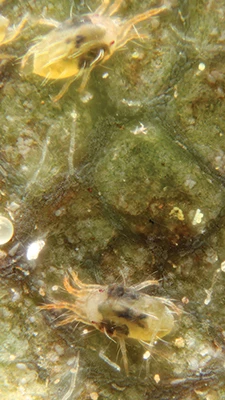
Meet the perp
 #1 Twospotted spider mites, Tetranychus urticae, are the most common spider mite pest in greenhouses. Adults are yellowish with a large black spot on each side. Twospotted spider mite eggs are round and pale yellow. Spider mites also produce silk webbing that accumulates shed skins and debris.
#1 Twospotted spider mites, Tetranychus urticae, are the most common spider mite pest in greenhouses. Adults are yellowish with a large black spot on each side. Twospotted spider mite eggs are round and pale yellow. Spider mites also produce silk webbing that accumulates shed skins and debris.
#2 Twospotted spider mites feed on most greenhouse vegetables and transplants including tomatoes, peppers, cucumbers, squash and lettuce. Spider mites do not fly, so they enter greenhouses on new plants, employee clothing and even vents since young mites can travel in wind currents.
#3 Twospotted spider mites feed on hundreds of plant species so they are found throughout the outdoor environment. In greenhouses, they feed on crop plants but can also reproduce on weeds and stock plants. Spider mites feed on the underside of leaves. They inflict damage leaves by puncturing leaf cells with their mouthparts and sucking out cell contents. This results in tiny brown dots on the leaf surface called stippling. Extensive stippling gives foliage a gray or brown cast and reduces plant growth.
#4 Twospotted spider mites can be present in greenhouses year-round. There is a greater chance mites will enter your greenhouse in summer when they are flourishing on weeds, field crops and other outdoor plants.
Monitoring
Because they are so tiny and reproduce quickly, monitoring for spider mites is essential. Don’t wait for mite damage to appear. Mite damage could take weeks to become noticeable on leaves. At that point, mites have been feeding for a while and you probably have a huge population.
Scout for mites by beating foliage against a white sheet of paper on a clipboard or paper plate. Mites will look like small dark spots moving slowly on the paper. You can also flip individual leaves to look for small dark spots and debris. Inspect any leaf that shows stippling.
Prevention
Sanitation is the best line of defense against spider mites. Mites will reproduce on weeds, so be sure to remove weeds from the inside and around the outside of greenhouses. Inspect new plants and cuttings before bringing them into a greenhouse as they could have mites. Over-fertilizing makes crop plants more nutritious for spider mites and can cause more rapid mite development. Some pyrethroid and neonicotinoid insecticides can also increase spider mite outbreaks.
Treatment of pest when present
A couple of predatory mite species and other biological control organisms are available to help manage spider mites. These — like all biological controls — are best used preventively because they do not provide rapid suppression of large populations.
Spider mite management should be implemented as soon as small populations are detected since mites are so damaging and reproduce so quickly. Select an appropriate miticide that is labeled for your crop since most insecticides do not kill mites very well. Each miticide only kills certain spider mite life stages. For example, some kill only juveniles or juveniles and adults, but some miticides also kill eggs.
Generally, I recommend making a couple of applications about a week apart. This improves management because if your miticide does not kill eggs then even if you killed every other mite in the greenhouse (and you won’t) eggs would hatch the next day. If your miticide doesn’t kill adults then you will have adults laying eggs even if you kill all the juveniles. Most miticides are not systemic, so thorough coverage of the undersides of leaves and inner leaves is critical.
Rotate between three different miticides with different modes of action. This will slow the development of resistance to a particular product. It will also help control mites that may have developed resistance elsewhere but come into your house on seedlings or cuttings.
Evaluate the efficacy of each application so you can switch products or apply on longer or shorter intervals as needed.
Steve Frank is Associate Professor and Extension Specialist at North Carolina State University. He conducts extension and research related to greenhouse pest management.

Explore the June 2015 Issue
Check out more from this issue and find your next story to read.
Latest from Produce Grower
- Nufarm announces unified brand
- Peckham acquires Revolution Farms in Michigan
- Fresh Express expands Chopped Salad Kits line with three new flavors
- The Growth Industry Episode 3: Across the Pond with Neville Stein
- University of Evansville launches 'We Grow Aces!' to tackle food insecurity with anu, eko Solutions
- Lawsuit challenges new H-2 visa rules
- Q&A: Sandra Eskin Leads Food Safety Advocacy Organization, STOP, as CEO
- Find out what's in FMI's Power of Produce 2025 report







